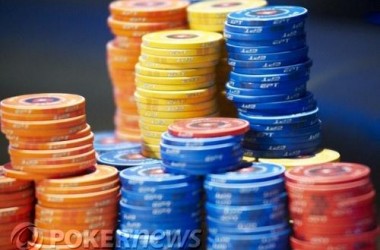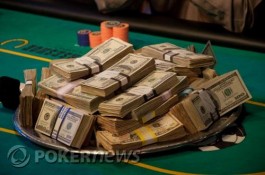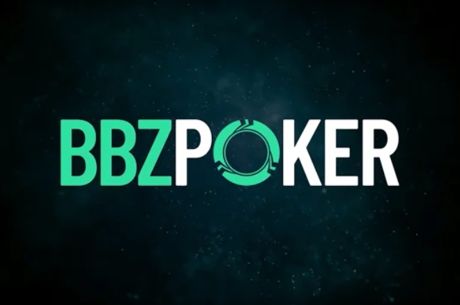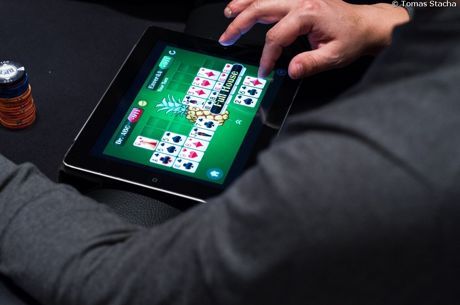Bankroll Builders, Vol. 10: 135-man Rush Poker SNGs, Part 2

In part one of this article, we gave you the skinny on where to play Rush Poker sit-n-goes, what sort of bankroll you’ll need to get started and advice on multi-tabling. Now we’ll get down to the nitty-gritty and take you through each stage of a 135-man Rush tourney, offering our tried-and-true "tips from the trenches" along the way.
Early-stage play
- When we talk about the early stages of a 135-man Rush SNG, we’re referring to the levels before the antes kick in, or about the first 35 minutes of play. During this stage of the tournament, the field shrinks from 135 players to about 45 to 50.
- Generally speaking, tight is right in the early levels. When you’re in early or middle position, use the quick-fold button and scroll through your junk hands. Sitting in the cutoff through the small blind, hang back a minute and wait to see what your opponents do before deciding whether or not to dump your hand. It’s OK to quick-fold that 7-8 offsuit in the small blind if someone has already raised, but if there ends up being three or four limpers in front of you, laying off the button will allow you to try and hit your hand by seeing a cheap flop.
- Take note of what position your raise is being called from. The presence of the quick-fold button can actually help you when it comes to defining an opponent’s range. Let’s say you made a standard opening raise from UTG+1 and the action folded all the way around to the small blind, who flat-called. I would instantly tighten up this player’s range of hands simply because of his position at the table. If he had any sort of marginal holding, more likely than not, he would have either (1) quick folded to start the hand or (2) quick folded to an early position raise. Because he didn’t quick fold, is out of position, and didn’t three-bet, I’m narrowing his range to hands like jacks to deuces, king-queen suited, king-jack suited and ace-ten through ace-queen.
- People tend to play extremely fast in the 135-mans, especially at the $4.40 level. More often than not, players are going to go with hands that flop top pair, a straight or flush draw, or even middle pair. With the sheer number of hands you’ll be able to see in the first half-hour of play (roughly 100 to 125) there should be at least one or two spots where you can capitalize on these tendencies and relentlessly value-bet your big hands.
Middle-stage play
- The middle stages of a 135-man Rush SNG refer to the time from when the antes kick in to when the final table begins. This generally encompasses the second half hour of play.
- Hopefully by this stage of the tournament, you’ve been able to increase your stack size and double up at least once. If you’re fortunate enough to have built a big stack, it’s time for you to start exploiting the average stacks and stealing their blinds. Loosen up your opening range from the button and the cutoff and start putting pressure on the blinds. At the same time, you’ll start discovering who is going to play back at you with a three-bet and who is going to give up more easily. If you’re hovering around more of a below-average stack size with 15-25 big blinds, it’s time to start picking spots to re-steal to give yourself enough of a stack to survive the bubble.
- Start taking notes when 30-35 players remain in the field. If you’re paying close enough attention, at this point you will see more and more of the same screen names popping up at your table. There are a variety of ways to do this. Most players will try and type straight into the notes feature of the Full Tilt client, but I’ve found that sometimes it’s easier to do it the old-fashioned way — with pen and paper. Develop your own shorthand and keep the notes objective and succinct. Something like “GonePhishin420 3B shoved 20bb A9o from SB to CO raise” will tell you more down the road than “GonePhishin420=total donk who stacked off w A9o and cracked my QQ!”
- With about 30 players remaining, play tightens up significantly as only 15 make the money. Keep taking notes. Which players are three-betting from the blinds? Which ones will fold to a three-bet after making a preflop raise? Who is showing down weak hands? Who is showing down huge hands? Also, keep your eyes on your opponents’ stack sizes. The lineup, the stack sizes, and your position on those stacks are changing every hand. For example, if the action is folded to you in the cutoff and you’re looking down at queen-nine suited, it might not be a bad spot to steal the blinds and pad your stack. However, if a player with only six big blinds is waiting for you in the small blind and shoves over your opening raise, pot odds will force you to call in a lot of spots and you’ll end up putting far more chips into the pot than you ever wanted to with a marginal hand.
- Don’t be afraid to run a well-timed bluff. In many ways, it’s easier to bluff in a Rush tournament, especially from position. With little or no reads to go on, opponents are more likely to give you credit for hitting a hand if you bet. If you sense weakness from your opponent, especially on a scary board, it might be the perfect time to try and steal the pot.
- Once the bubble bursts, it’s time to give your short-handed skills a workout. As the field decreases from 15 players to nine, play is four or five handed. Widen your range accordingly and pay attention to stack sizes.
Late-stage play
- Congratulations! You’ve reached the final table. Guess what? It’s not a Rush Poker tournament anymore! Once play is nine-handed, the “Rush period” ends and play proceeds like any other final table.
- Additionally, like any other turbo tournament, play at the final table will be pretty shallow-stacked. The average stack heading into the final table of a 135-man Rush SNG is around 25 big blinds.
- If you play online with the assistance of a HUD (heads-up display), you will have plenty of stats on your opponents when you hit the final table. After more than an hour of Rush Poker, each player will have logged about 250 hands. PokerTracker 3’s HUD currently works the best when it comes to Rush tournaments. It also runs beautifully on Macs. Hold’em Manager has recently updated their software to support the Rush format but there are still some bugs to be worked out.
Ready to start building your own bankroll? Open a Full Tilt Poker account today and get on the grind.








